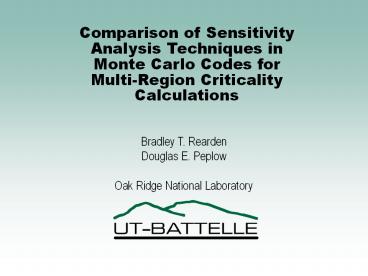Comparison of Sensitivity Analysis Techniques in Monte - PowerPoint PPT Presentation
Title:
Comparison of Sensitivity Analysis Techniques in Monte
Description:
Comparison of Sensitivity Analysis Techniques in Monte Carlo Codes for ... Employed inSEN3 analysis sequence using KENO V.a in SCALE. UT-BATTELLE ... – PowerPoint PPT presentation
Number of Views:97
Avg rating:3.0/5.0
Title: Comparison of Sensitivity Analysis Techniques in Monte
1
Comparison of Sensitivity Analysis Techniques in
Monte Carlo Codes for Multi-Region Criticality
Calculations
- Bradley T. Rearden
- Douglas E. Peplow
- Oak Ridge National Laboratory
2
Sensitivity and Uncertainty Analysis Techniques
- New techniques recently developed at ORNL to
determine applicability of critical experiments
for criticality code validation. - Use energy-dependent sensitivity coefficients and
cross section covariance data to assess
similarity of systems.
3
Sensitivity Methods in Monte Carlo Codes
- Differential Sampling
- Calculates the derivatives of the response with
respect to some parameter at the same time the
response is calculated. - First, second, third, etc. and cross derivatives
can be computed. - Available in MCNP and can be used for fixed
source or criticality problems. - MCNP manual cautions The track length estimate
of keff in KCODE criticality calculations assumes
the fundamental eigenvector (fission
distribution) is unchanged in the perturbed
configuration. - This means that the source dependence on the
parameter of interest is not taken into account
by the differential sampling, which could lead to
incorrect values of the derivatives if that
source dependence is large.
4
Sensitivity Methods in Monte Carlo Codes
- Perturbation Theory
- Independent forward and adjoint calculations
- Group-wise fluxes are computed and folded with
cross-section data to produce sensitivity
coefficients. - Only valid for small perturbations with linear
response. - Employed inSEN3 analysis sequence using KENO V.a
in SCALE.
5
GODIVA Sphere
- 8.7414 cm bare HEU metal
- 18.74 g/cm3
- 93.71 235U, and 5.27 238U, 1.02 234U
- ENDF/B-V data were used in both codes to ensure
consistency
6
Sensitivity Calculations
- Sensitivity of keff to fuel density was
investigated. - Over entire system
- Only in outer 2-cm thick shell
- Code generated sensitivity coefficients
- Direct Recalculation
- /- 10 in MCNP
- /- 5 in KENO V.a
7
Sensitivity Results
- Reasonable results for both codes for whole
system. - MCNP over-predicts outer shell by 40.
8
(No Transcript)
9
(No Transcript)
10
Explanation
- Differential Sampling
- When density of whole system is perturbed,
uniform change in source distribution. - Only outer 2-cm thick shell is perturbed,
non-uniform change in source distribution. - Perturbation Theory
- Forward fluxes are weighted with adjoint flux or
importance function
11
Possible Solution for Differential Operator
- Fixed source problem where source is function of
material density, accumulator stores sum of the
relative derivatives of interaction
probabilities, Pij - To include effect of source that is proportional
to density (Scr), start accumulator with
derivative of source with respect to density
12
Application to Criticality Problems
- Must be extended from generation to generation.
- Effect of each energy-dependent cross-section of
interest would have to be taken into account. - Would provide powerful tool for analysts with
ability to predict non-linear response to
perturbations. - For now, perturbation theory provides adequate
results for criticality applications.
13
(No Transcript)































